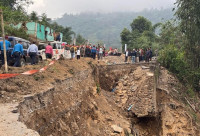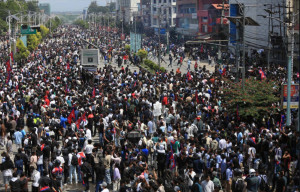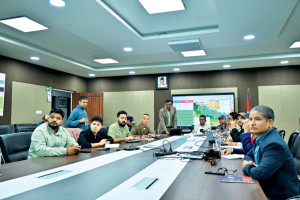Columns
Wetland conservation in Chure
Haphazard construction of physical infrastructures is a key reason for wetland loss.
Maheshwar Dhakal
Wetlands are a biodiversity hotspot and lifeline to many species of fauna and flora. A wetland is an ecosystem and provides drinking water to humans, irrigation water to farmers and habitats to mammals, birds, reptiles, fishes, herpetofauna and many others. Wetlands are also attractive destinations for tourists. People visit wetlands for entertainment activities including boating, swimming and photography. Poor and marginalised people live in and around the wetlands in developing countries like Nepal. They depend on wetland resources for their basic livelihoods. Wetlands also have additional value to climate change adaptation and play a vital role in making a resilient climate society.
Nepal is rich in wetlands and its biodiversity resources; around 6,000 small, medium large rivers and creeks, and more than 5,000 small to medium-sized ponds and lakes are distributed across the country. It is estimated that various wetlands cover around 5.6 percent of the country's total land area. Almost all wetlands in Nepal possesses freshwater, and even high-altitude wetlands and peatlands in the Himalayas sink a vast quantity of carbon. In 1988, Nepal became a party to the Ramsar Convention, an international pact that seeks to prevent the loss of wetlands and conserve the remaining ones. Nepal has enlisted 10 wetlands in the Ramsar List under the Ramsar Convention—Koshi Tappu, Bis Hazari, Jagdishpur and Ghodaghodi lakes in the Chure region; lake cluster of Pokhara and Mai Pokhara in the mid-hills; and Gokyo, Gosaikunda, Phoksundo and Rara in the high altitude region.
Multiple benefits
Wetlands provide multiple benefits to humans and nature itself. We need to encourage the people to conserve, manage, restore and love wetlands on an eternal basis, which is instrumental in finding nature-based solutions to problems faced by world communities including Covid-19 and climate change. It is necessary to have a broader understanding of the drivers of wetland loss and degradation to address the root causes. In Nepal, the haphazard construction of physical infrastructures, mainly rural roads in the mountains, is a key reason for wetland loss. Along with rainfall and runoff water, a massive quantity of silt is deposited in the lakes which is the main reason they are shrinking. Wetlands are also getting smaller as the water is drying up faster due to temperature rise. Therefore, we do not have time to lose to conserve, manage, restore and love the wetlands and utilise their goods and services on a sustainable basis.
Located between the plain lowlands (Tarai Madhes) in the south and the mid-hills (Mahabharat range) in the north, Nepal's Chure region comprises the youngest mountains in the country. The region covers 12.78 percent of the country's area and encompasses 37 districts. Forests cover around 72.37 percent of the land. More than 53 percent of the national population lives in the Chure and Tarai regions. Because of population growth and rapid migration, encroachment and deforestation are serious threats to wetland conservation. Rampant excavation of sand, boulders and stones from the Chure river systems by a strong corporate nexus of the private sector is another serious threat to Chure conservation and nearby wetlands.
The Chure region is considered to be a permanent water resource for drinking water and irrigation to the lowland people and farmers. Unfortunately, due to the exploitation of Chure's natural resources in devastating ways, there is a serious concern about whether the lowland is leading towards desertification and a water crisis in the days to come. Overexploitation of Chure resources has direct consequences on food and water security in the Chure region and downstream areas.
To conserve and secure the water resources for the people of the Chure and Tarai regions, the government of Nepal has given the highest priority to a national pride project called the President Chure-Tarai Madhes Conservation Area Programme. The programme has developed a 20-year master plan for the systematic intervention of conservation in the region, focusing on water resource conservation. The programme has constructed 557 conservation ponds at different locations for the purpose of water recharge in the lowlands. At the same time, 65 lakes and wetlands are being managed for biodiversity conservation and promotion of climate change adaptation in the region.
As the Chure region is young and fragile, the Chure conservation programme has constructed run water and runoff harvesting dams at 170 locations, which has instrumental effects on increasing the soil moisture and water recharge downstream. In addition, the programme has constructed 1,365 small-scale irrigation channels aiming to support agriculture production.
Building dams
The programme has also implemented water resource conservation at 548 sites. The riverbank protection activities add value to keeping intact river ecosystems upstream and protecting productive agricultural land downstream. The construction of check dams in flash flood areas of rivers rising in the Chure has supplementary value to trap the soil where it is in Chure and discharge clean water downstream. The Chure conservation programme has built check dams of various sizes at 846 locations for soil conservation and watershed management of the Chure region as a whole.
In recent years, the President Chure-Tarai Madhes Conservation Area Programme has given special attention to wetlands. Water dam construction sites are emerging as attractive destinations for domestic tourists. Some local communities have constructed picnic spots and other entertainment infrastructures in the vicinity of wetlands to attract people as tourist destination sites. These wetlands provide environmental services, increasing soil moisture and fertility, recharging water resources, and attracting people to the site as tourists. The wetlands perform multiple functions to generate additional sources of employment and income opportunities for local communities. Therefore, let's conserve, manage, restore and love the wetlands.




 18.12°C Kathmandu
18.12°C Kathmandu















